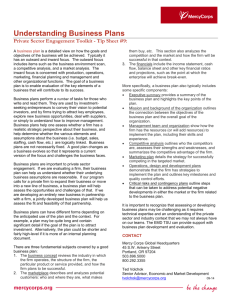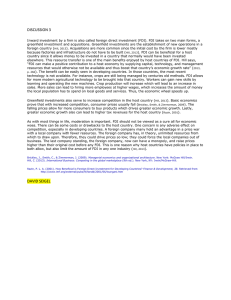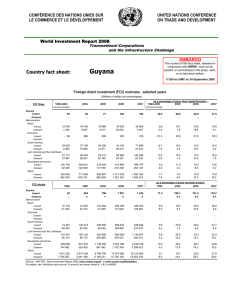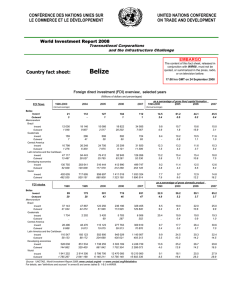New foreign direct investment statistics
advertisement
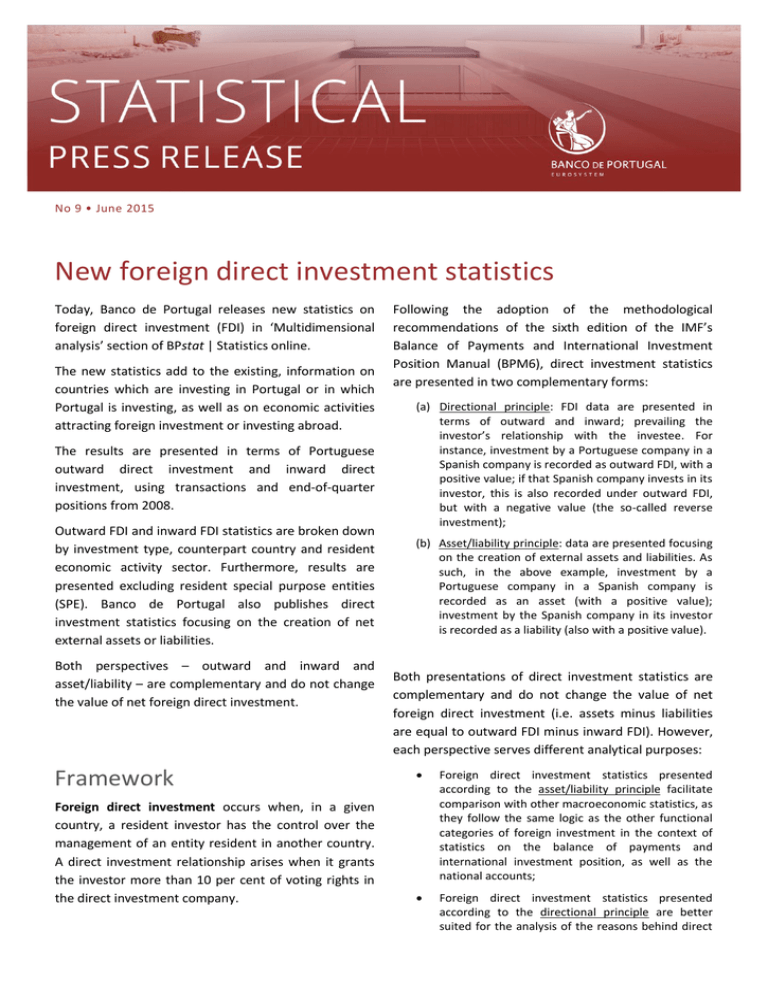
No 9 • June 2015 New foreign direct investment statistics Today, Banco de Portugal releases new statistics on foreign direct investment (FDI) in ‘Multidimensional analysis’ section of BPstat | Statistics online. The new statistics add to the existing, information on countries which are investing in Portugal or in which Portugal is investing, as well as on economic activities attracting foreign investment or investing abroad. The results are presented in terms of Portuguese outward direct investment and inward direct investment, using transactions and end-of-quarter positions from 2008. Outward FDI and inward FDI statistics are broken down by investment type, counterpart country and resident economic activity sector. Furthermore, results are presented excluding resident special purpose entities (SPE). Banco de Portugal also publishes direct investment statistics focusing on the creation of net external assets or liabilities. Both perspectives – outward and inward and asset/liability – are complementary and do not change the value of net foreign direct investment. Framework Foreign direct investment occurs when, in a given country, a resident investor has the control over the management of an entity resident in another country. A direct investment relationship arises when it grants the investor more than 10 per cent of voting rights in the direct investment company. Following the adoption of the methodological recommendations of the sixth edition of the IMF’s Balance of Payments and International Investment Position Manual (BPM6), direct investment statistics are presented in two complementary forms: (a) Directional principle: FDI data are presented in terms of outward and inward; prevailing the investor’s relationship with the investee. For instance, investment by a Portuguese company in a Spanish company is recorded as outward FDI, with a positive value; if that Spanish company invests in its investor, this is also recorded under outward FDI, but with a negative value (the so-called reverse investment); (b) Asset/liability principle: data are presented focusing on the creation of external assets and liabilities. As such, in the above example, investment by a Portuguese company in a Spanish company is recorded as an asset (with a positive value); investment by the Spanish company in its investor is recorded as a liability (also with a positive value). Both presentations of direct investment statistics are complementary and do not change the value of net foreign direct investment (i.e. assets minus liabilities are equal to outward FDI minus inward FDI). However, each perspective serves different analytical purposes: Foreign direct investment statistics presented according to the asset/liability principle facilitate comparison with other macroeconomic statistics, as they follow the same logic as the other functional categories of foreign investment in the context of statistics on the balance of payments and international investment position, as well as the national accounts; Foreign direct investment statistics presented according to the directional principle are better suited for the analysis of the reasons behind direct STATISTICAL PRESS RELEASE • June 2015 Banco de Portugal has published foreign direct investment statistics in accordance with both principles since October 2014, providing further details for data organised in accordance with the asset/liability principle, as an integral part of financial account and international investment position statistics. The series of releases launched today is designed to increase the informational value of foreign direct investment statistics organised in accordance with the directional principle. As such, quarterly statistics (transactions and end-of-quarter positions) since 2008 have been released on outward FDI and inward FDI with additional breakdowns by main resident economic activity sectors and partner countries. Individual information by country for the 20 largest outward FDI and inward FDI countries is also provided, as well as for the main geographical aggregates. The following pre-established analyses are provided in the ‘Multidimensional analysis’ section of BPstat | Statistics online, under ‘Foreign direct investment statistics - outward and inward direct investment’, which may be adjusted to user needs: (a) Outward and inward direct investment - main components; (b) Outward and inward direct investment excluding resident SPE (Special Purpose Entities); (c) Outward direct investment by economy; (d) Inward direct investment by economy; (e) Outward and inward direct investment by resident economic activity sector; (f) Outward and inward direct investment by economy and resident economic activity sector. Main highlights Chart 1 shows that end-of-period positions of foreign direct investment assets and liabilities exceed those for outward FDI and inward FDI respectively. Second, developments from 2008 to 2014 show that growth has been higher in accordance with the asset/liability principle, in terms of both assets and liabilities. Finally, as mentioned above, the overall value of net foreign direct investment is the same for both forms of presentation of FDI statistics. The fact that the net value is negative for the period as a whole means that Portugal invests abroad less than the direct investment it attracts from abroad. Chart 1 Asset/liability principle vs. Directional principle (end-of-period positions) Assets/liabilities principle 140 000 120 000 100 000 80 000 EUR millions investment. Given that they are typically broken down by country (or groups of countries) of the non-resident entity and by economic activity sector of the resident entity, these statistics help identify countries investing in Portugal and those in which Portugal is investing, as well as the economic activities attracting foreign investment or investing abroad. 60 000 40 000 20 000 0 -20 000 -40 000 -60 000 2008 2009 2010 Assets 2011 2012 2013 Liabilities 2014 Net Directional principle 140 000 120 000 100 000 80 000 EUR millions 2 60 000 40 000 20 000 0 -20 000 -40 000 -60 000 2008 2009 2010 Outward FDI 2011 2012 Inward FDI 2013 2014 Net STATISTICAL PRESS RELEASE • June 2015 Analysis by country The geographical breakdown of the new foreign direct investment statistics reflects the home country of the immediate counterpart. Therefore, when a company resident in country A invests in Portugal through an entity resident in country B, the latter country is taken into account in these statistics. Chart 2 shows that, at the end of 2014, the Netherlands and Spain are counterparts in approximately half of Portuguese outward and inward direct investment. For the same year, the 20 countries with the greatest outward FDI and inward FDI accounted, in both cases, for around 97% of total direct investment. Chart 2 Distribution of outward and inward FDI by country (end-of-period positions, 2014) Portuguese outward FDI Other countries; 27% Netherlands; 36% Angola, 6% Brazil; 6% Germany; 8% Other countries; 25% Spain; 17% Portuguese inward FDI Spain; 26% Brazil; 6% United Kingdom; 8% Luxembourg; 13% Netherlands; 23% 3 Analysis by resident economic activity sector FDI statistics by resident economic activity sectors show that, in the case of Portugal, both outward and inward FDI are mostly made via companies in the ‘Services’ sector. At the end of 2014, these companies accounted for approximately 97% of outward FDI and around 80% of inward FDI, most notably as regards ‘Financial and insurance activities‘.
